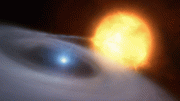
The 1.4 billion pixel camera of the Panoramic Survey Telescope & Rapid Response System (Pan-STARRS). Astromomers have used the system to study young brown dwarf stars in binary orbits around more normal young stars. Credit: Pan-STARRS
Using Pan-STARRS and UKIDSS, astronomers discovered 673 binaries with candidate brown dwarf companions.
Astronomers trying to understand how the Sun and Earth formed, and why they have their characteristic properties, have made progress on a closely related problem: the nature of the lowest mass stars, so-called “brown dwarfs.” These stars have masses of less than about 8% of the Sun’s mass. They are basically failed normal stars, and lack a sufficient force of gravitational contraction to heat up their interiors to the roughly ten million kelvin temperatures needed for hydrogen burning (hydrogen burning fuels the Sun). Not surprisingly they are extremely faint and hard to detect, and as a consequence our understanding of their evolution and interior properties is incomplete. Theorists predict that there could be as many brown dwarf stars as there are normal stars.
CfA astronomer Adam Kraus has joined with eight colleagues to use the Pan-STARRS 1 survey (the Panoramic Survey Telescope & Rapid Response System) and an infrared survey (UKIDSS) to search in a young, 5-10 million-year-old star-forming region for brown dwarfs. Pan-STARRS is a wide-field imaging telescope that combines a relatively small mirror, only 1.8 meters (6 feet), with a very large digital camera, about 1.4 billion pixels, to survey the sky on a continuous basis. The prototype single-mirror telescope PS1 has been operating on Mount Haleakala, Hawaii, since 2010; eventually, there will be four such systems working in concert.
The astronomers were studying the very early stages of brown dwarf development, and to help obtain reliable age estimates they used these surveys to search for objects that were in a binary system with young stars whose ages might be more tightly constrained, thus constraining the brown dwarf ages as well. The survey was able to pick out objects whose cool temperatures and reddish colors signaled that they were brown dwarfs, and the team discovered 673 binaries with candidate brown dwarf companions. Spectroscopic follow-up observations on four of them allowed the team to reach several conclusions: These companion brown dwarfs are infrequent, making up only about 0.6% of binaries, at least for those in which the stars are widely spaced (closer pairs were much more difficult to study). More puzzling, the scientists found that the brown dwarf companions are well enough understood to conclude that they did not form at the same time as their more normal, companion star. The puzzling result highlights the theoretical uncertainties in our understanding of brown dwarfs, while the new technique promises many more objects to begin the task of modeling. Meanwhile, the team has begun studying brown dwarfs in more normally spaced binaries, where they could be mistaken for large planets.
Reference: “A Pan-STARRS + UKIDSS Search for Young, Wide Planetary-Mass Companions in Upper Scorpius” by Kimberly M. Aller, Adam L. Kraus, Michael C. Liu, William S. Burgett, Kenneth C. Chambers, Klaus W. Hodapp, Nick Kaiser, Eugene A. Magnier and Paul A. Price, 25 July 2013, The Astrophysical Journal.
DOI: 10.1088/0004-637X/773/1/63
arXiv:1307.0506









Be the first to comment on "Astronomers Use Pan-STARRS to Detect Brown Dwarf Companion Stars"